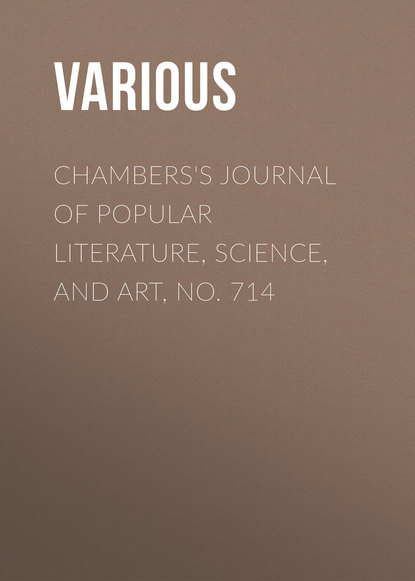По всем вопросам обращайтесь на: info@litportal.ru
(©) 2003-2024.
✖
Chambers's Journal of Popular Literature, Science, and Art, No. 714
Автор
Год написания книги
2017
Настройки чтения
Размер шрифта
Высота строк
Поля
PROFESSOR TYNDALL ON THE SPREAD OF DISEASE
We copy the following from our able contemporary, Nature. The views propounded have been already noticed in our paper on the 'Germ Theory.'
'In proposing a vote of thanks to Dr Corfield for his recent lecture on Infectious Diseases, Professor Tyndall paid a high compliment to the lecturer for the thoroughly sound instruction which he had so clearly conveyed. He had made it plain that contagion consisted, not of gas or vapour, but of definite particles, sometimes floating in gas, in the air we breathed, or in the water we drank; and that, like organic seeds in the soil, they multiplied themselves indefinitely in suitable media, the great probability being that these disease-producing particles were living things. A close study of the subject, extending now over several years, enabled him to agree entirely with the lecturer in the parallelism which he had declared to exist between the phenomena of contagious disease and the phenomena of ordinary putrefaction. The case of flies, for example, to which the lecturer ascribed the power of communicating disease from one person to another, was exactly paralleled by phenomena in putrefaction. Chop up a beefsteak, steep it in water, raise the temperature a little above the temperature of the blood, pour off the water, and filter it; you get a perfectly clear liquid; but that liquid placed in a bottle and exposed to the air soon begins to get turbid, and that turbid liquid, under the microscope, is found to be swarming with living organisms. By suitably heating this perfectly clear beef-tea, it can be sterilised, everything being killed which is capable of generating those little organisms which produce the turbidity; and by keeping it from coming in contact with the floating particles of the air, it might be preserved transparent for years. He had now some sterilised beef-tea of this sort which had been preserved for eighteen months in a state of perfect transparency. But if a fly dipped its foot into an adjacent vessel containing some of the turbid fluid, and then into the transparent fluid, that contact would be sufficient to infect the sterilised infusion. In forty-eight hours the clear liquid would be swarming with these living organisms. The quantity of the turbid liquid which attaches itself to the finest needle-point suffices to infect any amount of the infusion, just as the vaccine lymph taken up on the point of a surgeon's lancet spreads disease through the whole body. Here, also, as in the case of contagious disease, there was a period of incubation. In proof of what the lecturer had stated that the contagion of these communicable diseases was not gaseous or liquid, but solid particles, he would describe an experiment he had made only a few weeks since. Eighteen months ago he had a chamber prepared from which all floating particles of dust were removed, and in it he placed a number of vessels containing animal and vegetable refuse which soon fell into putrefaction, and also two or three vessels containing perfectly clear beef-tea and mutton-broth, as transparent as water, in which the infective particles had been killed by heat. Although all these vessels had stood for eighteen months side by side there had been no communication of contagion from one to the other. The beef-tea and mutton-broth remained as transparent as when put in, though the other vessels emitted a most noisome stench. But if a bubble were produced in one of the putrefying masses by blowing into it, and if on rising to the surface and bursting, the spray of the bubble was allowed to fall into the transparent beef-tea or mutton-broth, in two days it became as bad as its neighbours.
'Referring to another point on which the lecturer had insisted – namely, that there was no power of spontaneous generation of the germs or contagion of diseases, Professor Tyndall said that, though at present great names were opposed to that view, he would venture to predict that ten years hence there would be very few great names opposed to the lecturer on that matter. With regard to the power of specific contagia to be generated in decomposing animal matter, he would say that for the last twenty-one years he had been in the habit of visiting the upper Alpine valleys, where, amongst the Swiss châlets, there was the most abominable decomposition going on from day to day, and exceedingly bad smells, but there these contagious diseases were entirely unknown. If, however, a person suffering from typhoid fever were transported there, the disease would spread like wildfire from this infected focus, and probably take possession of the entire population. It might be taken, therefore, that any of these special diseases required its special germ or seed for its production, just as you required a grape-seed to produce a vine. He entirely agreed with all that Dr Corfield had stated as to these diseases 'breeding true.' He never found the virus of small-pox producing typhoid, or vice versâ. The subject was one of the most important which could engage the attention of the scientific physician.'
notes
1
The subject of 'Visible Speech' is not unfamiliar to the readers of Chambers's Journal. In the number for May 12, 1866, a succinct account of the system is given – a system intended to remedy the utter want of agreement between the appearance and the sound of a letter or a word.











